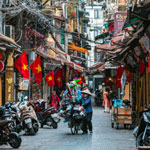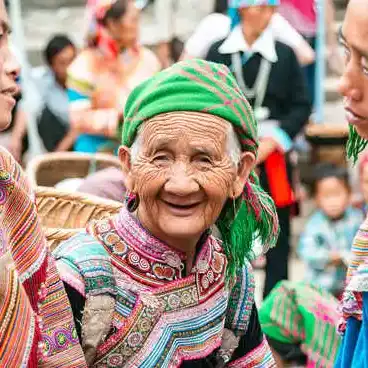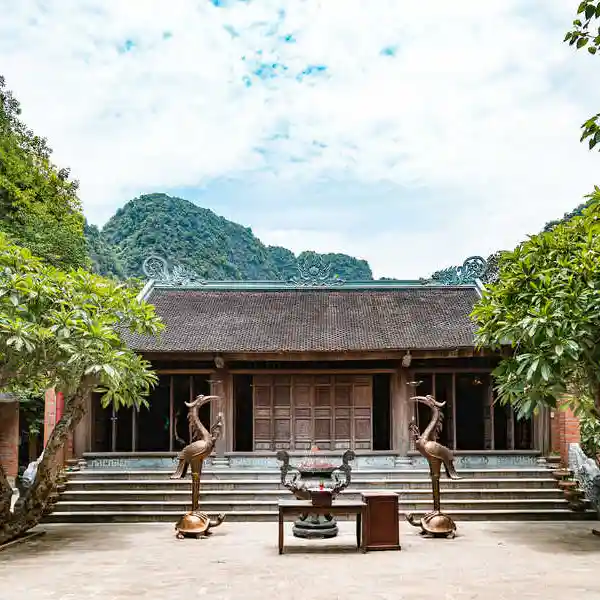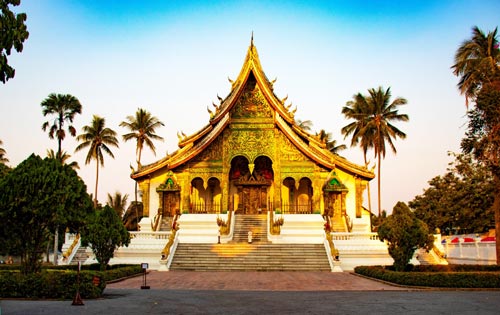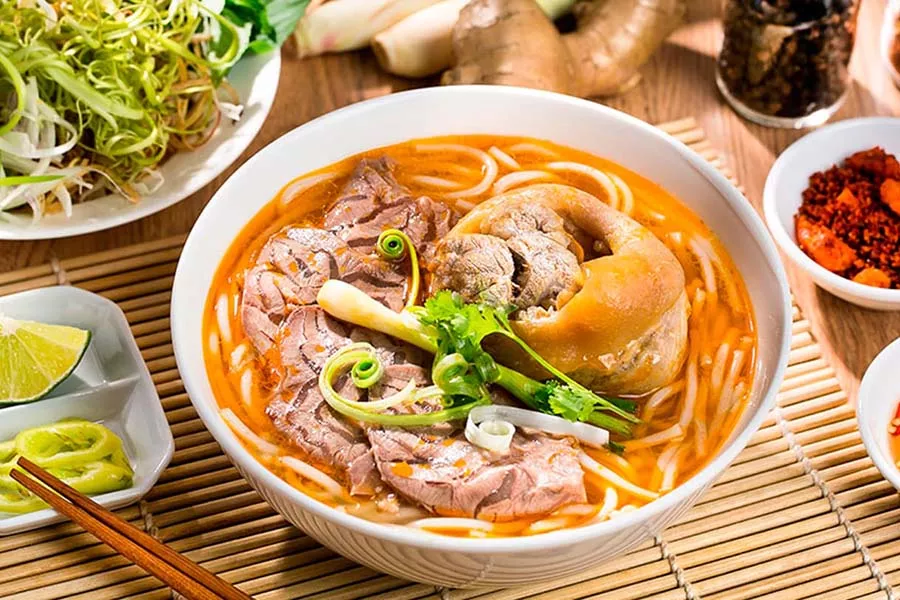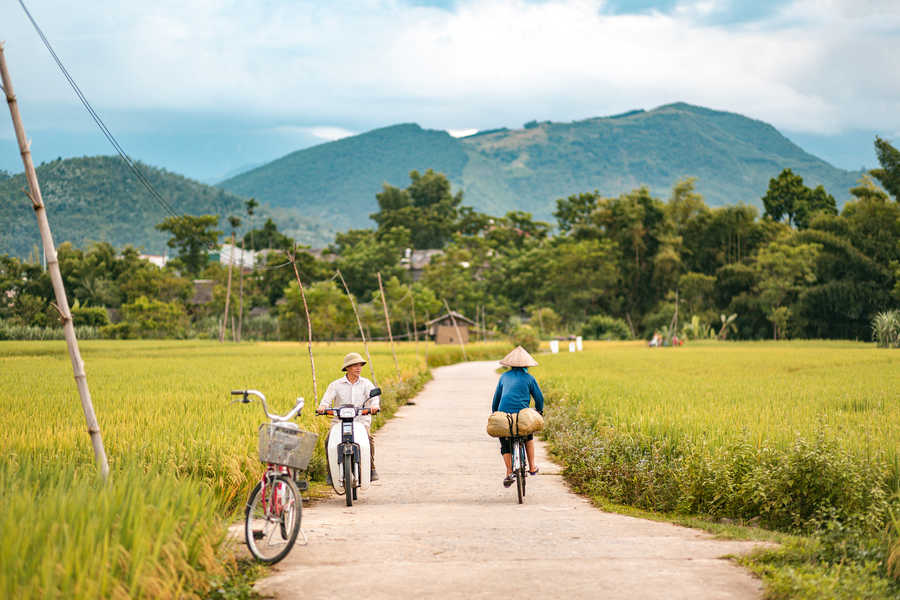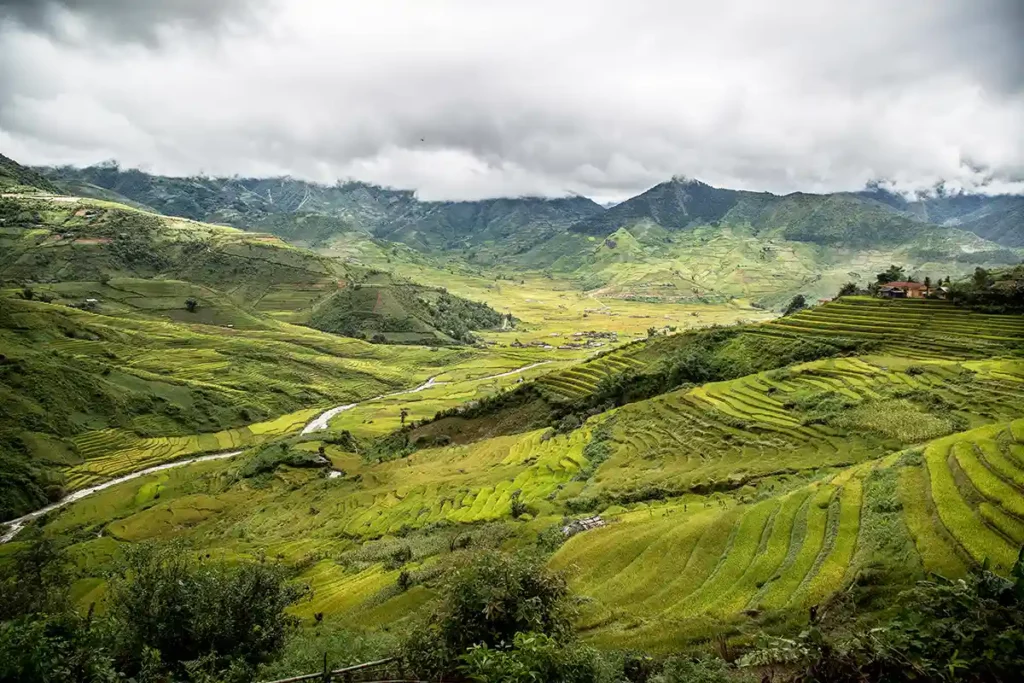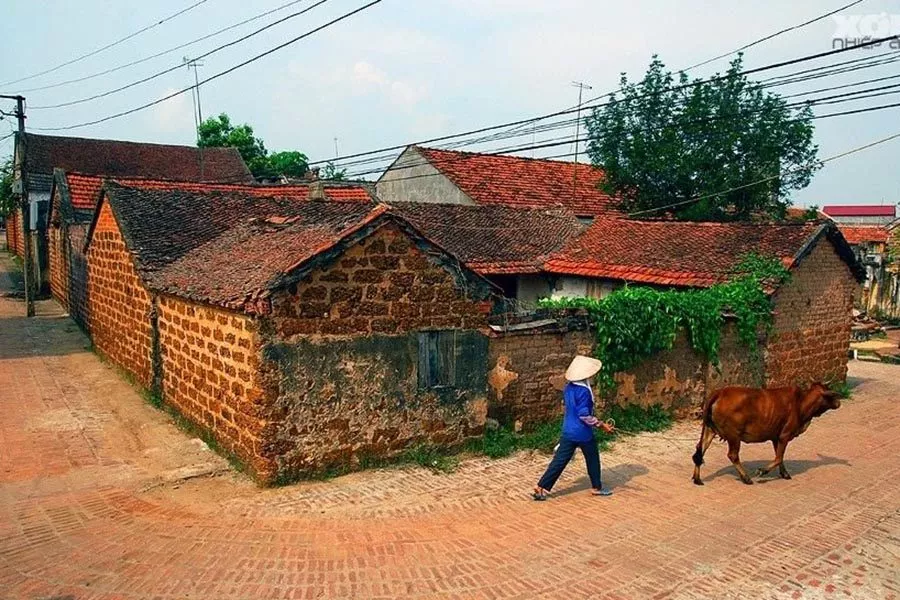The city of Hué has a rich history. It was first the capital of the Kingdom of Southern Vietnam (“Cochinchina”), ruled by the Nguyen family from the 17th century. With the Nguyen dynasty’s control over the entire Vietnamese territory from 1802, Hué became the capital of the Empire.
Renowned for its artistic and intellectual prominence, the city flourished until the arrival of French troops in the 1880s.
Throughout this period (17th century to the late 19th century), the cuisine at the royal court — first of the King, then of the Emperor — played a significant role in the city’s cultural influence.
Let’s explore the origins of this cuisine together, along with the many dishes we recommend you try during your visit to the city.
Les origines de la gastronomie de Hue
Nguyen Phuc Anh (1762–1820), founder of the Nguyen imperial dynasty (he took the name Gia Long — “Gia” being the former name of Saigon and “Long” from “Thanh Long,” the old name of Hanoi), established the Lý Thiện department, which can be translated as the “royal mouth.” Dozens of people worked to prepare the many dishes that were to be presented to the Emperor at each meal. We’re talking about around fifty dishes per meal! Of course, the Emperor couldn’t finish it all… the “leftovers” were given to his concubines and the mandarins (high-ranking officials). This tradition continued throughout the reigns of successive Emperors, even though some preferred much simpler flavors.
Each dish had to be refined — from the selection of ingredients to the preparation and presentation. Balance in flavors and colors was paramount, not to mention the nutritional value of the dishes, which provided the Emperor with the energy needed to manage the affairs of the Empire.
It was truly at the imperial court that emphasis was placed on cuisine as a means of cultural influence throughout the Empire.
Alongside this royal cuisine, a popular street cuisine also developed — equally colorful and bold in its presentation, as if the streets were an extension of the imperial gastronomy.
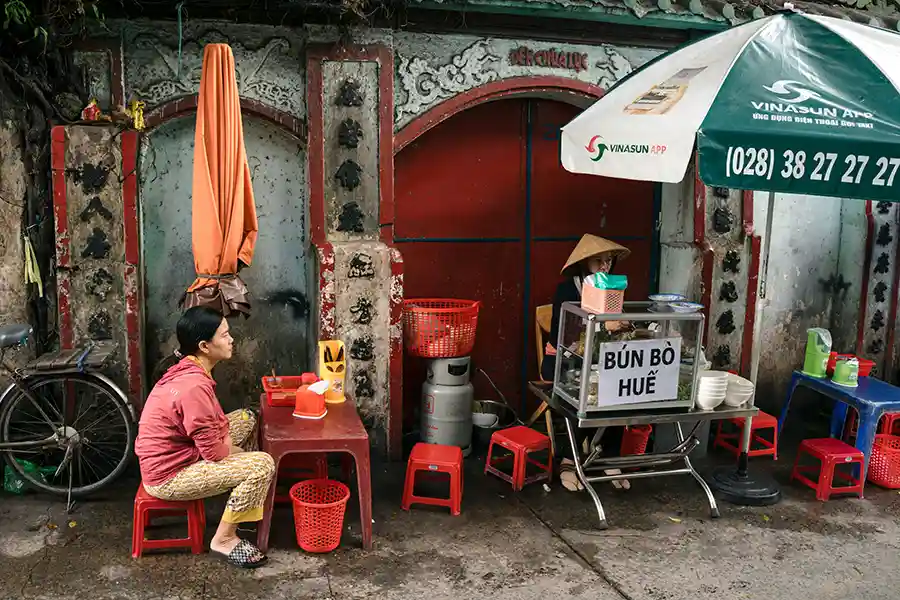
A small street restaurant in Hué.
Let’s now discover the must-try dishes during your visit to Hué.
The Best Dishes of Hué
Most of Hué’s dishes have been exported throughout Vietnam. The dishes often retain “Hué” in their names to highlight the unique characteristics of the cuisine from the former imperial city.
We’ll divide the dishes into three categories:
- Main dishes, which can satisfy your appetite;
- Rice cakes, which make perfect appetizers;
- The desserts
Main Dishes
Bun Bo Hué (rice vermicelli with pork and beef)
The iconic popular dish of Hué! It’s a soup made with rice noodles (Bun) and beef (Bo).
The unique flavor of the soup comes from simmering beef bones and shank with lemongrass, the dominant aroma in Bun Bo Hué. But the flavors don’t stop there — a wide variety of condiments are added: coriander, chives, onions, banana flower, mint… Not to mention chili and sugar, essential for that Southern Vietnamese touch! Finally, the dish includes mam ruoc (shrimp paste) and often coagulated pork blood.
This dish is therefore very hearty and can easily serve as a complete lunch! Be warned — the Hué recipe, more than others, is quite spicy!
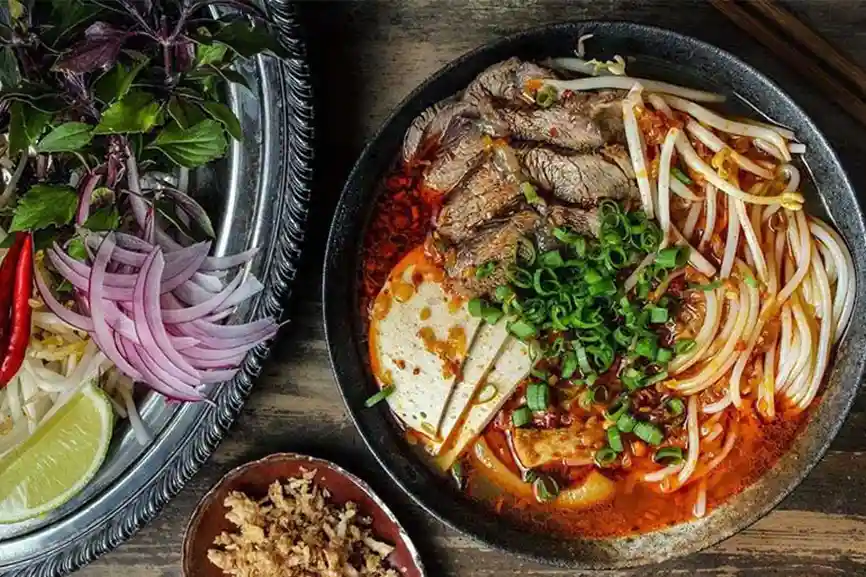
Bun Bo Hué, an iconic dish.
Here are our top spots to try Bun Bo in Hué:
- Bun Bo Ba Tuyet No 47 Nguyen Cong Chu (open from 6h to 11h)
- Quan O Phung No 5 Nguyen Du (open from 15h to 18h)
Com Hen Hué (rice with baby clams) or Bun Hen Hué (noodles with baby clams)
One of the dishes locals adore and miss the most when they are away from Hué.
The rice (com) or rice noodles (bun) are here paired primarily with baby clams (hen), collected along the rivers around Hué. These two main ingredients are mixed with fresh elements like banana leaves, green mango, and a wide variety of herbs and condiments, as is typical for Hué dishes. Fried pork rind and mam ruoc (shrimp paste) are also included on your plate.
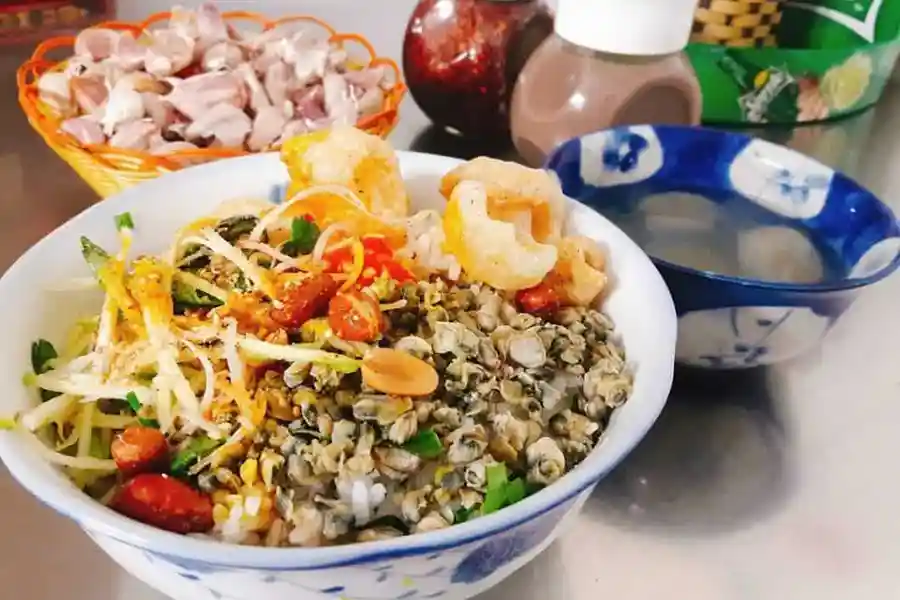
Cơm Hến Hué.
Our favorite spot for com/bun hen: Hoa Dong restaurant, run by Mrs. Hoa. She is part of the third generation managing this restaurant, which first opened in the 1960s.
Bun Thit Nuong Hué (rice vermicelli with grilled meat)
Another delicious noodle dish! Unlike Bun Bo Hué, this dish is served cold and dry (without soup). If you’re not in the mood for a soup, Bun Thit Nuong is the perfect choice!
The noodles and lemongrass-grilled pork are mixed with a variety of fragrant herbs and vegetables (carrots, daikon radish, papaya, cucumber). The dish is then sprinkled with crushed peanuts and fried onions. Finally, your plate is drizzled with nuoc mam sauce flavored with garlic and chili!
You can try this dish right on the street, and you’ll likely be drawn in by the irresistible smell of grilled meat!
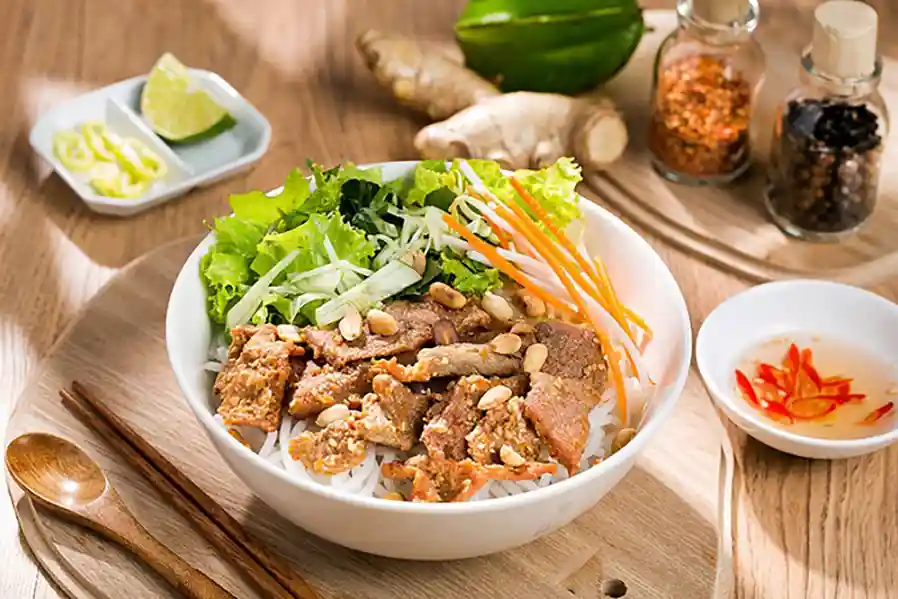
Bun Thit Nuong Hue.
Here are our top spots to try Bun Thit Nuong:
- No 38 Ba Trieu
- No 130 Tran Phu
- No 179 Mai Thuc Loan
Around 30,000 VND for a plate.
Banh Canh Ca Loc (snakehead fish soup)
Here’s a lesser-known dish that offers an alternative to soups made with beef or pork. Banh Canh are rice and tapioca noodles — longer than bun and with a soft texture. For this dish, the noodles are served with a fish called “Lóc” (snakehead fish).
To try this dish, we recommend visiting Nguyen Trai and Han Thuyen streets in the evening, where you’ll find several small specialized restaurants. The dish is very affordable — around 20,000 VND per bowl.
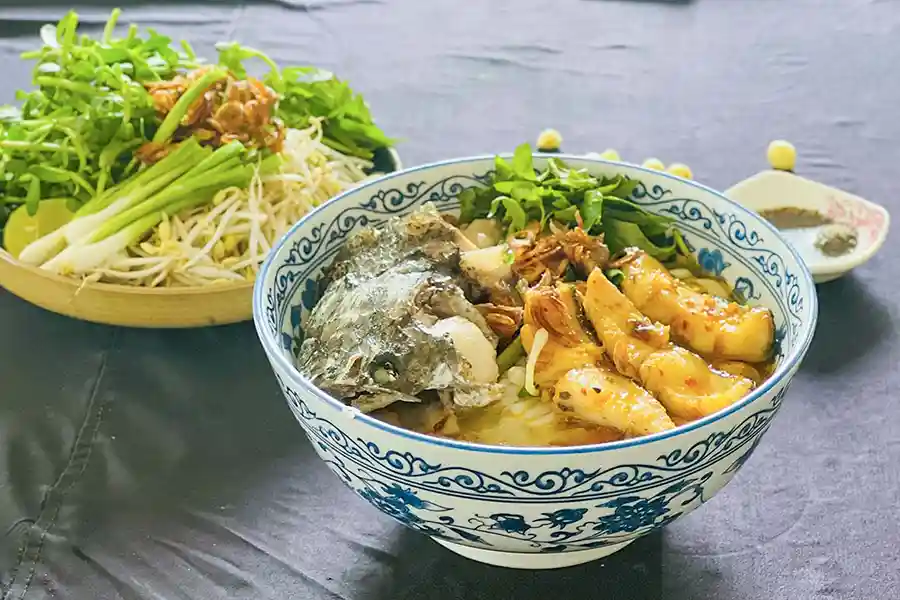
Bánh Canh Cá Lóc in Hue
Nem Lui (pork skewers)
A simple dish: pork is cooked around a lemongrass stalk. Once served, it’s time to get to work — you’ll make your own nem with herbs and vegetables. Everything is then dipped into nuoc mam sauce before being enjoyed.
Locals enjoy nem lui as a snack with beer before dinner. Just like with Bun Thit Nuong, you won’t be able to resist the aroma of grilled pork and lemongrass for long.
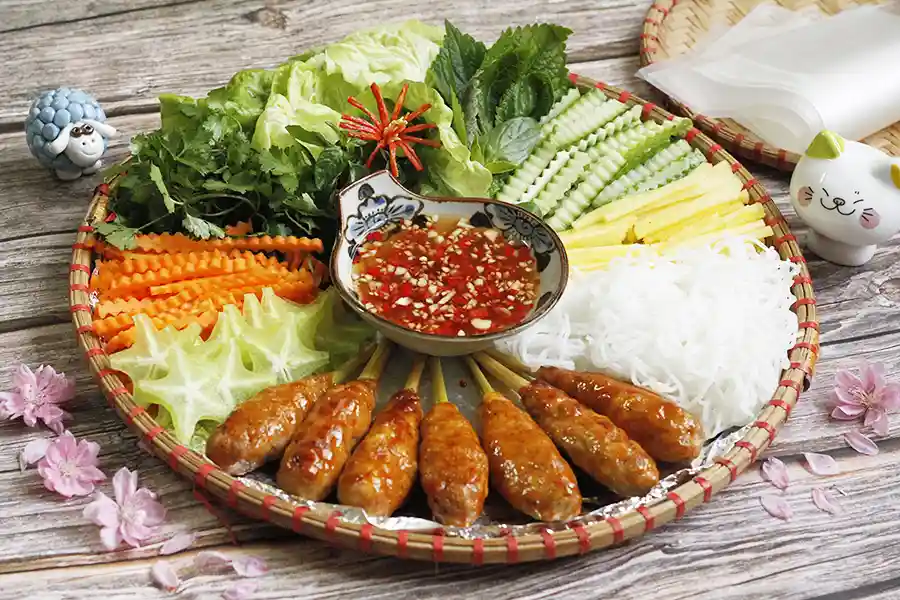
Nem Lui in Hue.
Rice Cakes
Banh khoai– Hue crepe
You may have heard of Banh Xeo, a traditional dish from Southern Vietnam. Banh Khoai is Hué’s version of Banh Xeo! It’s a rice flour pancake filled with pork, shrimp, and bean sprouts. Sometimes, you’ll also find an egg inside. Of course, it’s all served with condiments, a few chilies, and a peanut sauce!
Unlike Banh Xeo, Banh Khoai are usually served “open,” not folded or rolled.
Depending on your appetite, it can be eaten as a main dish or as a snack!
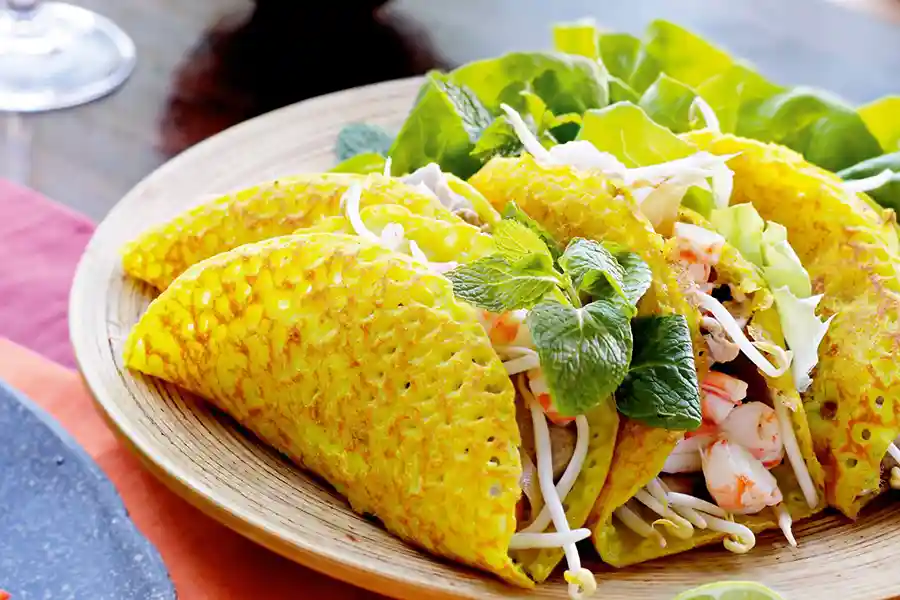
Bánh khoai– Hue
Here are our top spots to try Banh xèo in Hué:
- Banh Khoai Hanh No 11 Pho Duc Chinh
- Banh Khoai Lac Thien No 6 Dinh Tien Hoang
- Banh Khoai va bun thit nuong No 305 Nguyen Trai
Banh Beo Chen – shrimp crackers
These are small cakes made from rice and tapioca flour. On top of the batter, dried shrimp pieces and crispy pork skin mixed with onion oil are added.
Banh Beo are small and served on a tray so that everyone can help themselves. It’s a perfect, social appetizer for lunch or dinner!
Our favorite spot to enjoy Bánh Bèo Chén: Nha Hang Me – 12 Vo Thi Sau.
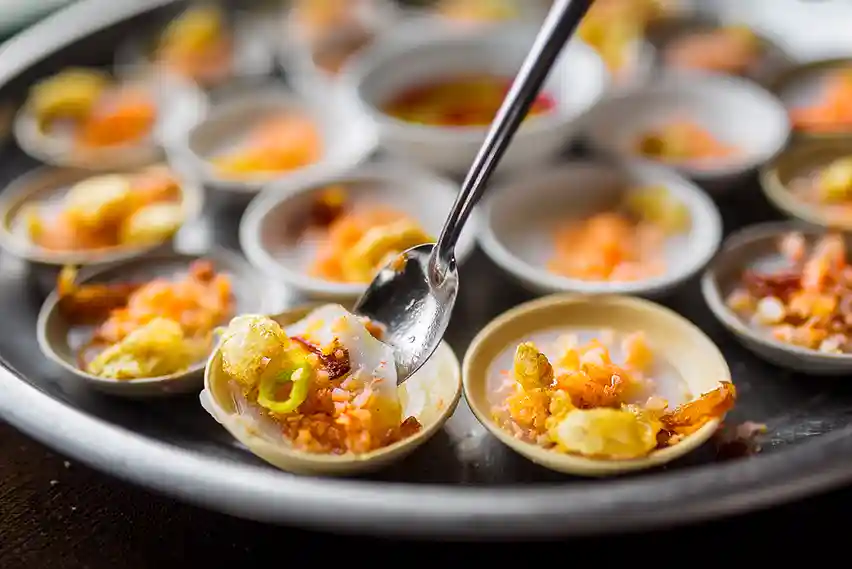
Banh Beo chén Hue.
Banh Ram-It – Hué dumplings
A true guilty pleasure! A type of three-layered dumpling:
- The base is made of a crispy, fried rice cake.
- On top, there’s a glutinous rice dumpling filled with beans, shrimp pieces, and pork belly.
- The whole is topped with sliced onions and shrimp.
The crunchy and sticky textures complement each other perfectly. It can be enjoyed at any time of the day!
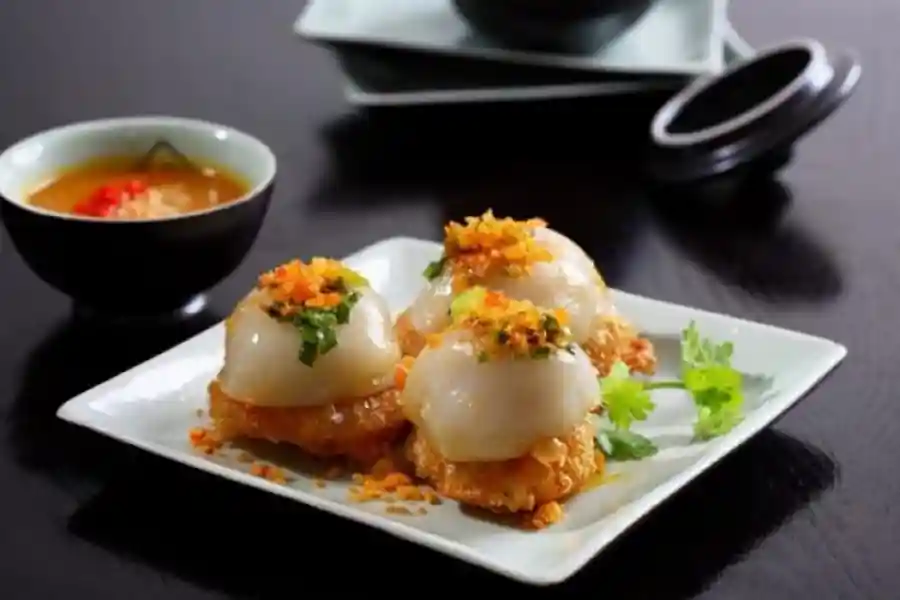
Bánh ram-ít Hue.
Our favorite spot to enjoy banh ram it: Quán Hàng Me – 14 Võ Thị Sáu, Phú Hội
Banh Bot Loc (translucent shrimp dumplings)
Made with rice and tapioca flour (Bột), the dough becomes translucent (lọc). The “cake” (Bánh) is then filled with a whole shrimp and sliced pork.
The dumplings can then be wrapped in banana leaves. In that case, they are called bánh bột lọc lá, with the last word meaning “leaf.”
Our favorite spot to enjoy banh bot loc :
- Quan Thuy Banh – 16 Pham Hong Thai
- Ba Do – 8 Nguyen Binh Khiem
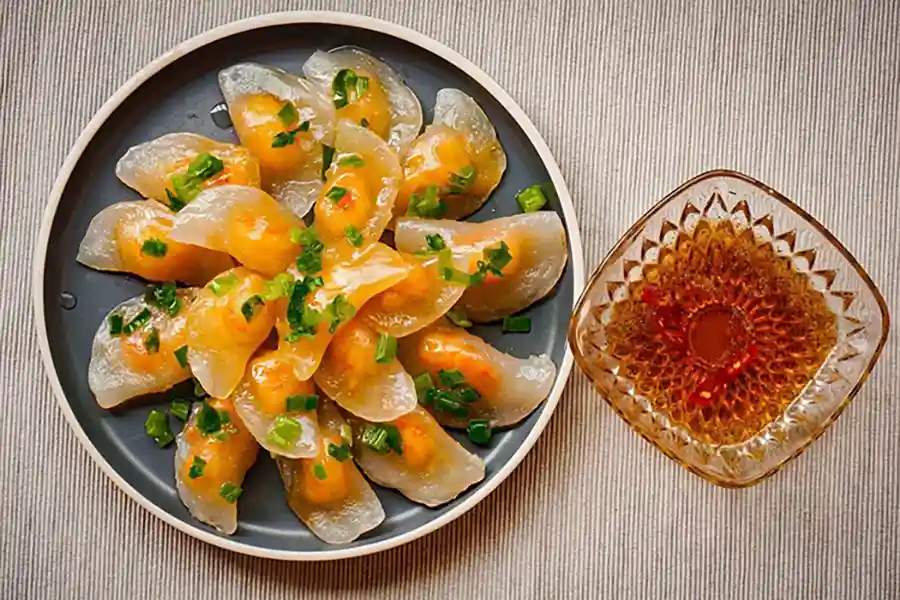
Bánh Bột Lọc in Hue
Banh Nam
Here’s a fourth version of these “shrimp cakes” found in Hué. This time, the dumpling is flat and wrapped in a banana leaf. Gently open the leaf and enjoy!
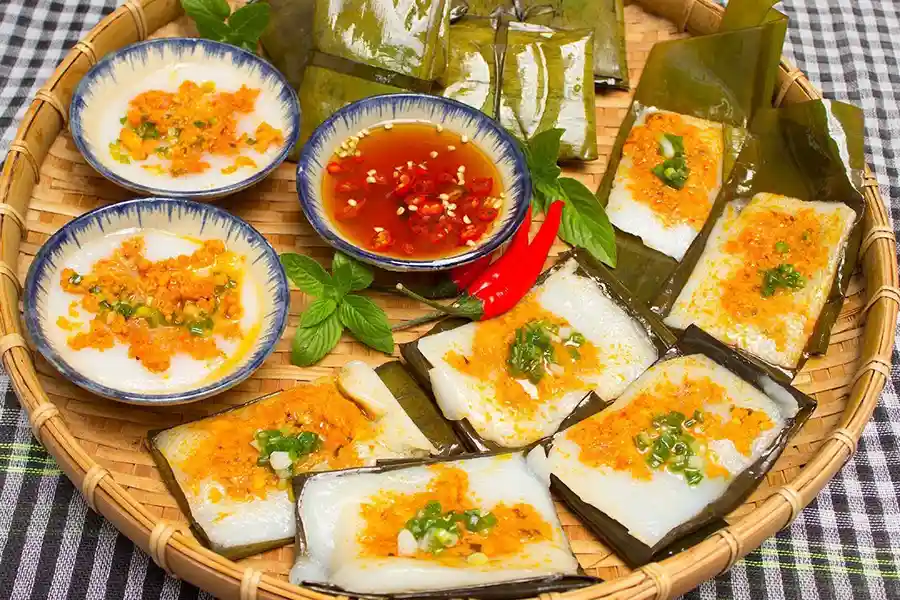
Banh Nam, Hue dishes, Vietnam
Sweet and Fruity Desserts
Le Trai Va – an original local fruit
Trai Va can only be found in the Hué region. It belongs to the vegetable family but… is refreshing and flavorful! It is used in salads, soups, or sometimes even as a meat substitute.
We recommend visiting vegetarian restaurants, where you’re sure to find trai va.
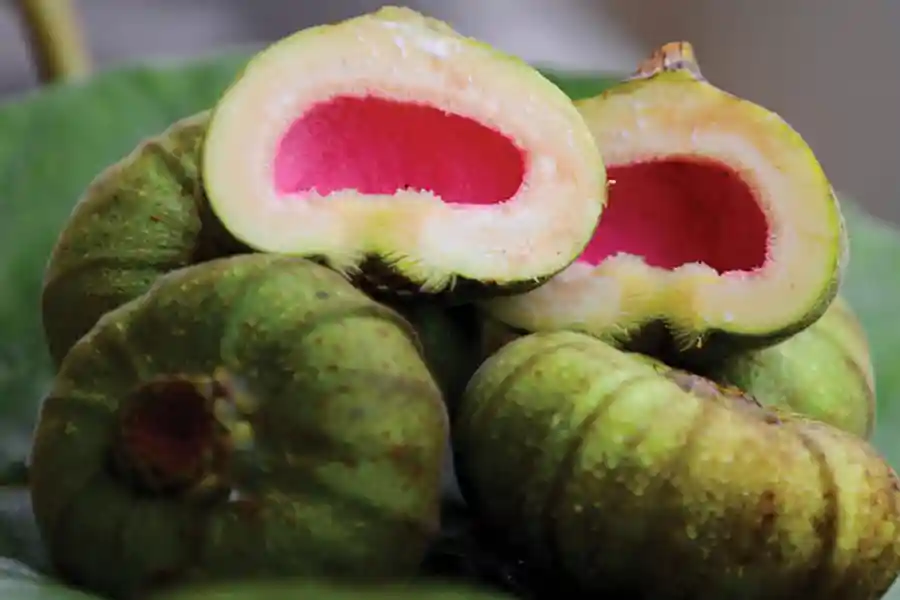
Trai Va, special fruit in Hue
Che bot loc thit heo quay – Hué dessert
Let’s finish with Hué’s iconic dessert… Chè is a kind of pudding made from mung and red beans, tapioca, jelly, coconut cream, and fruits… In fact, you can add just about any ingredients you like!
What makes Hué’s version special? Ginger and… pork jelly! If that combination doesn’t put you off, give it a try! Otherwise, you can indulge in the many other types of chè available.
The best chè can be found along the streets. You’ll see many children enjoying chè after school — the Vietnamese version of an afternoon snack!
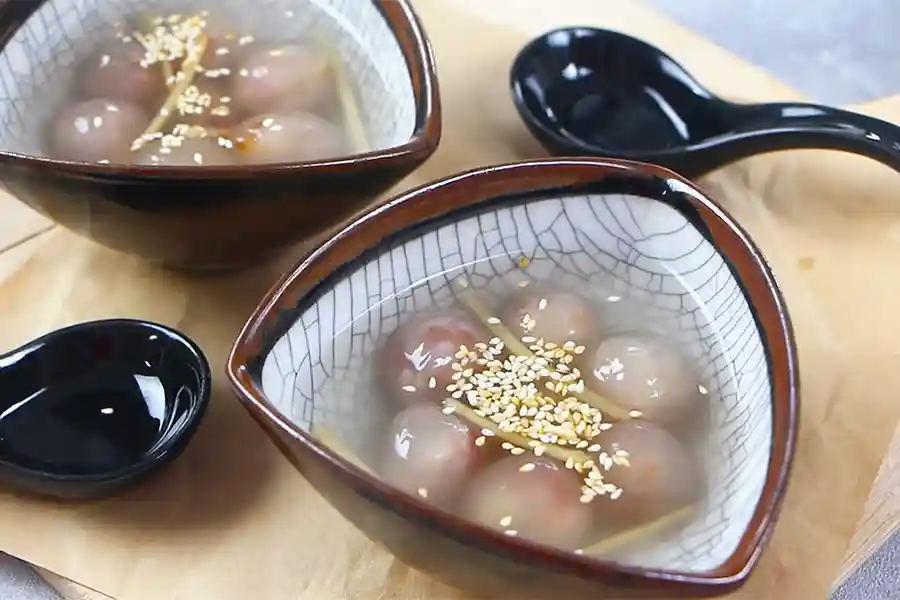
Le Che bot loc thit heo quay, Hue
You now know the must-try dishes of Hue!
All that’s left is for us to wish you… ENJOY YOUR MEAL!






